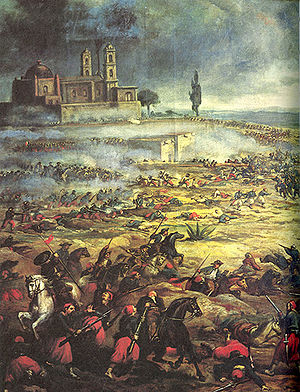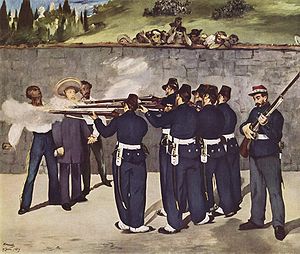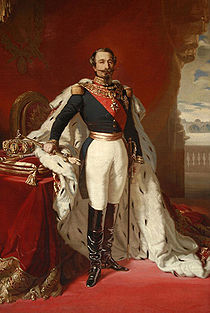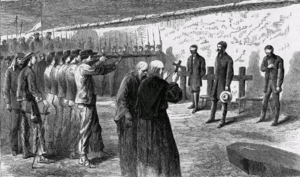- French intervention in Mexico
-
Franco-Mexican War 
Battle of PueblaDate 8 December 1861 - 21 June 1867 Location Mexico Result French withdrawal, end of the Mexican Empire, Republican victory Belligerents  Second French Empire
Second French Empire
 Second Mexican Empire
Second Mexican Empire
 Austrian Empire (German and Hungarian volunteers)
Austrian Empire (German and Hungarian volunteers)
 Belgian Foreign Legion[1]
Belgian Foreign Legion[1]
 Egyptian Sudanese[2]
Egyptian Sudanese[2]
Supported by :
 Kingdom of Spain (retired in 1862)
Kingdom of Spain (retired in 1862)
 United Kingdom (retired in 1862)
United Kingdom (retired in 1862) United Mexican States
United Mexican States
Supported by :
 United States of America (entered in 1865)
United States of America (entered in 1865)Commanders and leaders Maximilian I of Mexico ☠
Charles de Lorencez
François Achille Bazaine
Elie Frédéric Forey
Miguel Miramón ☠
Tomás Mejía ☠
Joan Prim
Alfred van der SmissenBenito Juárez
Ignacio Zaragoza
Porfirio Díaz
Mariano Escobedo
José María Yáñez
Manuel Doblado †
Juan N. MéndezStrength French : 38,493[3]
Mexican imperialists : 20,000
Austrian-Hungarian : 7,000[3]
Belgians : 2,000[3]
Sudanese : 450[4]Mexican republicans : 80,000 Casualties and losses French : 6,654[3] (including 5,000 from disease[5])
Mexican imperialists : 5,600[5]
Austrian-Hungarian : ?
Belgians : ?Mexican republicans : 32,000[5]
300,000[5] Mexican civiliansFrench intervention
in Mexico
(1862–1867)- Fortín
- Las Cumbres
- Atlixco
- Puebla
- Barranca Seca
- Cerro del Borrego
- Jonuta
- Siege of Puebla
- San Pablo del Monte
- Tampico
- Camarón
- Mexico City
- Chiapa de Corzo
- Morelia
- Guanajuato
- Guadalajara
- Jahuactal
- Campeche
- San Juan Bautista
- Mazatlán
- Acapulco
- Durango
- Nanahuatipam
- Majoma
- Monterrey
- Matamoros
- Totoapan
- Colima
- Jiquilpan
- San Pedro
- Cuauhtémoc
- El Rosario
- Tacámbaro
- La Loma
- Parral
- Chihuahua
- Álamos
- Ixmiquilpan
- Bagdad
- Santa Isabel
- Chihuahua
- Siege of Jonuta
- Santa Gertrudis
- Miahuatlán
- Juchitán
- La Carbonera
- Guayabo
- Guadalajara
- Villa de Álvarez
- San Jacinto
- Monterrey
- 2 de Abril
- Lomas de San Lorenzo
- Siege of Querétaro
- Mexico City
History of Mexico 
This article is part of a seriesPre-Columbian Mexico Spanish conquest Colonial period War of Independence First Empire First Republic War with Texas Pastry War Mexican–American War Second Federal Republic The Reform Reform War French intervention Second Empire Restored Republic The Porfiriato Revolution La decena trágica Plan of Guadalupe Tampico Affair Occupation of Veracruz Cristero War The Maximato Petroleum nationalization Mexican miracle Students of 1968 La Década Perdida 1982 economic crisis Zapatista Insurgency 1994 economic crisis Downfall of the PRI
Mexico Portal
The French intervention in Mexico (Spanish: Segunda Intervención Francesa en México), also known as The Maximilian Affair, War of the French Intervention, and The Franco-Mexican War, was an invasion of Mexico by an expeditionary force sent by the Second French Empire, supported in the beginning by the United Kingdom and the Kingdom of Spain. It followed President Benito Juárez's suspension of interest payments to foreign countries on 17 July 1861, which angered Mexico's major creditors: Spain, France and Britain.
Napoleon III of France was the instigator, justifying military intervention by claiming a broad foreign policy of commitment to free trade. For him, a friendly government in Mexico would provide an opportunity to expand free trade by ensuring European access to important markets, and prevent monopoly by the United States. Napoleon also needed the silver that could be mined in Mexico to finance his empire. Napoleon built a coalition with Spain and Britain at a time the U.S. was engaged in a full-scale civil war. The U.S. protested but could not intervene directly until its civil war was over in 1865.[6]
The three powers signed the Treaty of London on October 31, to unite their efforts to receive payments from Mexico. On 8 December the Spanish fleet and troops from Spanish-controlled Cuba arrived at Mexico's main Gulf port, Veracruz. When the British and Spanish discovered that the French planned to invade Mexico, they withdrew.
The subsequent French invasion resulted in the Second Mexican Empire, which was supported by the Roman Catholic clergy, many conservative elements of the upper class, and some indigenous communities; when the presidential terms of Benito Juárez (1858–71) were interrupted by the rule of the Habsburg monarchy in Mexico (1864–67). Conservatives, and many in the Mexican nobility, tried to revive the monarchical form of government (see: First Mexican Empire) when they helped to bring to Mexico an archduke from the Royal House of Austria, Maximilian Ferdinand, or Maximilian I of Mexico (who married Charlotte of Belgium, also known as Carlota of Mexico), with the military support of France. France had various interests in this Mexican affair, such as seeking reconciliation with Austria, which had been defeated during the Franco-Austrian War, counterbalancing the growing U.S. power by developing a powerful Catholic neighbouring empire, and exploiting the rich mines in the north-west of the country.
Contents
- 1 1862: Arrival of the French
- 2 1863: The French take the capital
- 3 1864: Arrival of Maximilian
- 4 1865: Beginning of Republican victories
- 5 American perspective
- 6 1866: French withdrawal and Republican victories
- 7 1867: Republicans take the capital
- 8 French expeditionary force, 31 December 1862
- 9 See also
- 10 References
- 11 External links
1862: Arrival of the French
The British, Spanish and French fleets arrived at Veracruz, between 6 January and 8 January 1862 intending to pressure the Mexicans into settling their debts. The city of Campeche surrendered to the French fleet on 27 February, and a French army, commanded by General Lorencez, arrived on 5 March. When the Spanish and British realized the French ambition to conquer Mexico, they withdrew their forces on 9 April, their troops leaving on 24 April. In May, the French man-of-war Bayonnaise blockaded Mazatlán for a few days.
The French army suffered an initial defeat in the Battle of Puebla on 5 May 1862 (commemorated with the Cinco de Mayo holiday) against the Mexican forces commanded by General Ignacio Zaragoza. The pursuing Mexican army was then contained by the French at Orizaba, Veracruz, on 14 June. More French troops arrived on 21 September, and General Bazaine arrived with more reinforcements on 16 October. Tampico, Tamaulipas, was occupied by the French on 23 October, with Xalapa, Veracruz, taken peacefully on 12 December.[citation needed]
1863: The French take the capital
The French bombarded Veracruz on 15 January 1863. Then, on 16 March, General Forey and the French Army began the siege of Puebla.
On 30 April, the French Foreign Legion earned its legendary status in the Battle of Camarón when the small infantry patrol unit led by Captain Jean Danjou numbering 62 soldiers and three officers was attacked and besieged by Mexican infantry and cavalry units numbering three battalions, and was forced to make a defense in Hacienda Camarón. Danjou was mortally wounded in the defense of the hacienda, and the last of his men mounted a desperate bayonet attack. They fought to nearly the last man, with three survivors. To this day, 'Camerone Day' is still the most important day of celebration for Legionnaires.
The French army of General François Achille Bazaine defeated the Mexican army led by General Comonfort in their attempt to relieve the siege of Puebla, at San Lorenzo[disambiguation needed
 ], to the south of Puebla. Puebla surrendered to the French shortly afterward, on 17 May. On 31 May, President Juárez fled the city with his cabinet, retreating northwards to El Paso del Norte and later to Chihuahua, where the government-in-exile remained until 1867, taking the treasure of the state with them.
], to the south of Puebla. Puebla surrendered to the French shortly afterward, on 17 May. On 31 May, President Juárez fled the city with his cabinet, retreating northwards to El Paso del Norte and later to Chihuahua, where the government-in-exile remained until 1867, taking the treasure of the state with them.French troops under Bazaine entered Mexico City on 7 June 1863. The main army entered the city three days later led by General Forey. General Almonte was appointed the provisional President of Mexico on 16 June, by the Superior Junta (which had been appointed by Forey) The Superior Junta with its 35 members met on 21 June, and proclaimed a Catholic Empire on 10 July. The crown was offered to Maximilian, due to Napoleon's efforts. Maximilian accepted the crown on 3 October, at his castle Miramar near Trieste, having been offered it by the Comisión Mexicana, sent by the Superior Junta.
1864: Arrival of Maximilian
On 28 and 31 March 1864, men from the French man-of-war Cordelière tried to take Mazatlán, but were repelled by Mexicans commanded by Colonel Gaspar Sánchez Ochoa.
The French under Bazaine occupied Guadalajara on 7 January 1864, and troops under Douay occupied Zacatecas on 6 February. Further French victories continued with the fall of Acapulco on 3 June, occupation of Durango on 3 July, and the defeat of republicans in the states of Sinaloa and Jalisco in November.
Maximilian formally accepted the crown on 10 April, signing the Treaty of Miramar, and landed at Veracruz on 28 May (or possibly 29 May) 1864 in the SMS Novara. He was enthroned as Maximilian, Emperor of Mexico. Maximilian of Habsburg was very much the product of the progressive ideas in vogue in the West at the time. He favoured the establishment of a limited monarchy sharing powers with a democratically-elected congress and inspired laws that abolished child labour, limited working hours, and abolished a system of land tenancy that virtually amounted to serfdom among the Indians. This was too liberal to please Mexico's conservatives, while the liberals refused to accept a monarch, leaving Maximilian with few enthusiastic allies within Mexico.
On Sunday, November 13, 1864, three French men-of-war (Victoire, D'Assas and Diamante) shelled Mazatlán 13 times, and Imperial Mexican forces under Manuel Lozada entered and captured the city.
1865: Beginning of Republican victories
The French continued with victories in 1865, with Bazaine capturing Oaxaca on 9 February (defeating the city's defenders under General Porfirio Díaz). The French fleet landed soldiers who captured Guaymas on 29 March. However on 11 April, republicans defeated Imperial forces at Tacámbaro in Michoacán. In April and May the republicans had many forces in the states of Sinaloa and Chihuahua. Most towns along the Rio Grande were also occupied by republicans. The Belgian volunteers were defeated by the republicans at the Second Battle of Tacámbaro on 11 July.
The decree known as the "Black Decree" was issued by Maximilian on 3 October, which threatened any Mexican captured in the war with immediate execution. This was the later basis of his own execution. Several high-ranking republican officials were executed under this order on 21 October.
American perspective
American President Abraham Lincoln had supported the republicans under Juárez, but was unable to intervene due to the American Civil War. Immediately after the end of the war, in 1865, United States Army General Philip Sheridan, under the supervision of President Andrew Johnson and General Ulysses S. Grant, assembled 50,000 troops, and dispatched them to the border between Mexico and the United States. There, his corps ran patrols to visibly threaten intervention against the French, and also supplied weapons to Juárez's forces.[7] The United States Congress had unanimously passed a resolution which opposed the establishment of the Mexican monarchy on 4 April 1864. On 12 February 1866, the US demanded the French withdraw their forces from Mexico, moved soldiers to positions along the Rio Grande, and set up a naval blockade to prevent French reinforcements from landing. The US officially protested to Austria about the Austrian volunteers in Mexico on 6 May.
1866: French withdrawal and Republican victories
In 1866, Napoleon III announced the withdrawal of French forces beginning 31 May. The Republicans won a series of victories after the end of the French military support to the Imperial troops, occupying Chihuahua on 25 March, taking Guadalajara on 8 July, further capturing Matamoros, Tampico and Acapulco in July. Napoleon III urged Maximilian to abandon Mexico. The French evacuated Monterrey on 26 July, Saltillo on 5 August, and the whole state of Sonora in September. Maximilian's French cabinet members resigned on 18 September. The Republicans defeated imperial troops in the Battle of Miahuatlán in Oaxaca in October, occupying the whole of Oaxaca in November, as well as parts of Zacatecas, San Luis Potosí and Guanajuato. On 6 December the Austrian and Belgian volunteers disbanded and were supposed to join the Mexican Army; however, 3500 of the 4648 volunteers did not enlist, and tried to leave the country.
 Édouard Manet's Execution of the Emperor Maximilian (1867) is one of five versions of his representation of the execution of the Mexican monarch
Édouard Manet's Execution of the Emperor Maximilian (1867) is one of five versions of his representation of the execution of the Mexican monarch
On 13 November, Ramón Corona and the French agreed to terms for the liberation of Mazatlán. At noon the invaders boarded three men-of-war, Rhin, Marie and Talisman and departed.
1867: Republicans take the capital
The Republicans occupied the rest of the states of Zacatecas, San Luis Potosí and Guanajuato in January. The French evacuated the capital on 5 February.
On 13 February 1867, Maximilian withdrew to Querétaro. The Republicans began a siege of the city on 9 March, and Mexico City on 12 April. An imperial sortie from Querétaro failed on 27 April.
On 11 May, Maximilian resolved to attempt an escape through the enemy lines. He was, however, intercepted before he could carry out this plan on 15 May and, following a court-martial, was sentenced to death. Many of the crowned heads of Europe and other prominent figures (including Victor Hugo and Giuseppe Garibaldi) sent telegrams and letters to Mexico pleading for Maximilian's life to be spared, but Juárez refused to commute the sentence, believing that it was necessary to send a message that Mexico would not tolerate any government imposed by foreign powers.
Maximilian was executed on 19 June (along with his generals Miguel Miramón and Tomás Mejía) on the Cerro de las Campanas, a hill on the outskirts of Querétaro, by the forces loyal to President Benito Juárez, who had kept the federal government functioning during the French intervention. Juárez's position was further strengthened when the United States deployed troops to the Rio Grande, and threatened an invasion. Mexico City surrendered the day after Maximilian was executed.
The republic was restored, President Juárez was returned to power in the national capital, yet there was little change in policy given that Maximilian had upheld most of Juárez's liberal reforms.
After the victory, the Conservative party was so thoroughly discredited by its alliance with the invading French troops that it effectively ceased to exist, and the Liberal party was almost unchallenged as a political force during the first years of the "restored republic". In 1871, however, Juárez was re-elected to yet another term as president in spite of a constitutional prohibition of re-elections, provoking one of the losing candidates, Porfirio Díaz (a Liberal general and a hero of the French war, but increasingly conservative in outlook) to launch a rebellion against the president. Supported by conservative factions within the Liberal party, the attempted revolt (the so-called Plan de la Noria) was already at the point of defeat when Juárez died in office on 19 July 1872, making it a moot point. Díaz ran against interim president Sebastián Lerdo de Tejada, lost the election, and retired to his hacienda in Oaxaca. Four years later, in 1876, when Lerdo himself ran for re-election, Díaz launched a second, successful revolt (the Plan de Tuxtepec) and captured the presidency, which he effectively held through eight terms until 1911.
French expeditionary force, 31 December 1862
At its peak, the French expeditionary force counted 38,493 men (Which represented 20% of the French army)[3]. 6,654[3] French died, including 5,000 from disease[5]. Among these losses, 1,918[5] of the deaths were from a single regiment of the French Foreign Legion.
Général de Division Forey
- 1er Division d'Infanterie (GdD Bazaine)
- 1er Brigade (GdB de Castagny)
- 18e Bataillon de Chasseurs
- 1er Régiment de Zouaves
- 81e Régiment de Ligne
- 2e Brigade (GdB ?)
- 20e Bataillon de Chasseurs
- 3eme Régiment de Zouaves
- 95e Régiment d'infanterie Légère
- Bataillon de Tirailleurs Algériens
- 2x Marine artillery batteries
- 1er Brigade (GdB de Castagny)
- 2e Division d'Infanterie (GdB Douay - acting)
- 1er Brigade (Col Hellier - acting)
- 1er Bataillon de Chasseurs
- 2e Régiment de Zouaves
- 99e Régiment d'infanterie Légère
- 2e Brigade (GdB Berthier)
- 7e Bataillon de Chasseurs
- 51e Régiment de Ligne
- 62e Régiment de Ligne
- 2x Army artillery batteries
- 1er Brigade (Col Hellier - acting)
- Brigade de Cavallerie (GdB de Mirandol)
- 1er Régiment du Marche (2 squadrons each of 1er and 2e Chasseurs d'Afrique)
- 2e Régiment du Marche (2 squadrons each of 3eme Chasseurs d'Afrique and 12e Chasseurs)
- Naval Brigade
- Bataillon de Fusiliers-Marin
- 2e Régiment d'Infanterie de Marine
Not yet arrived:
- 7e Régiment de Ligne
- 1e Régiment Etranger
- 2e Bataillon d'Infanterie legère d'Afrique
- Bataillon Egyptien
- det/ 5e Régiment de Hussards
See also
- Pastry War, an earlier invasion of Mexico by the French
- Reform War
- History of Mexico
- List of battles of the French intervention in Mexico
- Cinco de Mayo
References
- Notes
- ^ Thompson, David. "Mexican Heritage Coupled to Lively History of Silver State." Nevada Observer, April 5, 2001, http://www.nevadaobserver.com/Archive/040501/Featurestory.htm and Ridley, Jasper. Maximilian and Juarez. New York: Ticknor & Fields, 1992. 232-233
- ^ Magyar király helyett mexikói császár - III. Napóleon és Habsburg Miksa kalandja Mexikóban (regnumportal.hu)
- ^ a b c d e f http://www.histoiredumonde.net/article.php3?id_article=1201
- ^ http://www.danielpipes.org/716/a-black-corps-delite-an-egyptian-sudanese-conscript
- ^ a b c d e f http://www.militaryhistoryonline.com/19thcentury/articles/FrenchInMexico.aspx
- ^ Michele Cunningham, Mexico and the Foreign Policy of Napoleon III, Palgrave Macmillan, 2001
- ^ Sheridan, p. 405.
- Bibliography
- Bancroft, Hubert Howe. History of Mexico: being a popular history of the Mexican people from the Earliest Civilization to the Present Time The Bancroft Company, New York, 1914, pp. 466-506
- Corti, Egon Caesar. Maximilian and Charlotte of Mexico (2 vol 1968). 976 pages
- Cunningham, Michele. Mexico and the Foreign Policy of Napoleon III, Palgrave Macmillan, 2001
- Garay, Lerma. Antonio. Mazatlán Decimonónico, Autoedición. 2005. ISBN 1-59872-220-4.
- Sheridan, Philip H. Personal Memoirs of P.H. Sheridan, Charles L. Webster & Co., 1888, ISBN 1-58218-185-3 (vol. 2, part 5, Chapter IX)
- Topik, Steven C. "When Mexico Had the Blues: A Transatlantic Tale of Bonds, Bankers, and Nationalists, 1862-1910," American Historical Review, June 2000, Vol. 105 Issue 3, pp 714-40
External links
Categories:- French intervention in Mexico
- Invasions
- 19th-century colonization of the Americas
- 19th century in France
- 19th century in Mexico
- 1861 in Mexico
- 1862 in Mexico
- 1863 in Mexico
- 1864 in Mexico
- 1865 in Mexico
- 1866 in Mexico
- 1867 in Mexico
Wikimedia Foundation. 2010.




